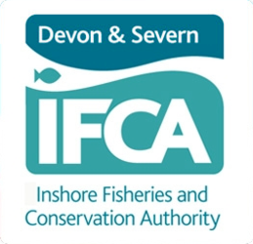Mariculture within D&S IFCA’s district
- Home
- Environment & Research
- Mariculture
- Mariculture within D&S IFCA’s district
Page review/updated 11/10/2023
Mariculture is an important component of the diverse range of fisheries within D&S IFCA’s District. Shellfish currently dominates production with multiple species in the District being farmed. Production of Blue mussels Mytilus edulis make up the bulk production within the District, followed by Pacific oysters Magallana gigas (aka Crassostrea gigas). There is also Mariculture on a much smaller scale, usually by individual stakeholders on the following species: surf clams, scallops, and native oysters. Seaweed cultivation, though not yet established within the District, is seen as a potential Mariculture opportunity and future industry development is expected.
Production of shellfish occurs primarily on the South Devon coast, in and around the mouths of estuaries and within large bays, notably Lyme Bay and Torbay. Methods of cultivation can, even within species, vary considerably. This is largely due to not only the preference of the shellfish farmer, but also down to the oceanographic and environmental characteristics of the local habitat and area. Some estuaries and bays prove more productive for some species than others and vice versa.
All Mariculture sites within the D&S IFCA’s District are certified by CEFAS and undergo regular testing of E.Coli levels within the flesh of the animal as a proxy for environmental contamination. This ensures that all products are classified based on the water quality of the farmed site, and the shellfish from the site is subject to the correct treatment to ensure that it meets EC Food Health Regulations necessary for commercial sale. An ‘A’ classification means that shellfish can be sold without any further action; ‘B’ classification means the product must be subject to depuration (purifying) or relaying on an A site before sale, and Category ‘C’ means relaying on a site with an A or B classification, for a period of time followed by that classification’s treatments. A site in a ‘D’ category is completely prohibited for the harvesting of shellfish, for further info please see: https://www.cefas.co.uk/cefas-data-hub/food-safety/classification-and-microbiological-monitoring/.
EXE ESTUARY
The Exe Estuary is well known for its intertidal mussel habitat with wild beds dominating parts of the intertidal, and whilst there have been substantial declines to wild populations in recent years due to environmental factors leading to closure of the public beds, the growing and harvesting of cultivated subtidal mussel has seen only gains. This is largely due to the efforts of Exmouth Mussels Ltd, a shellfish production company who collect spat from outside the estuary and then relays it on private subtidal and intertidal beds within the estuary. Since dredging is prohibited in the Exe Estuary under D&S IFCA’s Mobile Fishing Permit Conditions due to the estuary being designated as a European Marine Site (SPA) and SSSI, the company developed a novel way of collecting the mussel using an elevator harvester which deploys powerful jets of water to dislodge the mussel from the benthos before collection by conveyer directly on to the boat. Both classified areas involved in mussel production are long-term Bs.
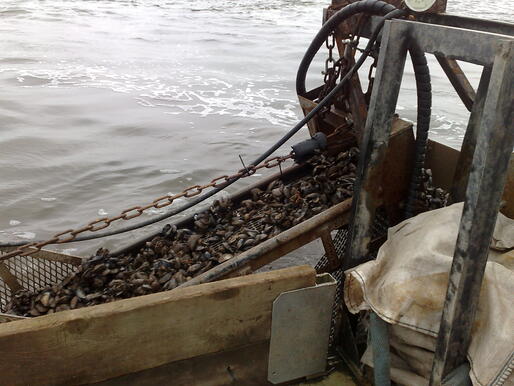
Pacific oysters, since their successful introduction in the UK in the 1960s, have also been farmed in the Exe Estuary. This typically occurs in bags on trestles in the low intertidal using hatchery grown spat. The bags are filled with spat, and then will be turned every spring tide to prevent biofouling. After 6-8 months the contents of bags will be emptied and the oysters within graded by size; differing size classes will then be placed in new bags and replaced on to the trestles. These graded bags have lower low stocking densities to facilitate better nutrient uptake and subsequently faster growth and lower mortality. The whole process, from spat to commercial sized adults can take from 18-30 months dependent on local environmental conditions. Waters classified for M. gigas in the Exe are classified as B or long-term B.
There is a current proposal to start farming oysters on the Exe Estuary using hanging baskets. Hanging baskets are attached to long lines and work in a similar way to the bags-on-trestle method but they reduce dependence on working the spring tides as they can be accessed by boat. The oysters produced by this method are also seen to create a higher quality product as the shells are often smoother (from tumbling in the hanging baskets ) than the bag-on-trestle grown oysters. Efforts have also begun to restore native oysters Ostrea edulis for cultivation on the private beds to the west of the Estuary (waters classified B).
A commercial cockle fishery did take place in some areas of the Exe Estuary but due to a haplosporidian shell disease which caused gaping of the shells and mass mortality of the larger cockles, this made the fishery unviable.
TEIGN ESTUARY
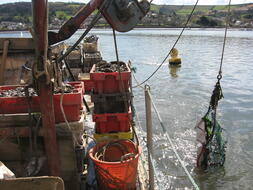
The Teign Estuary like the Exe Estuary had large historic wild intertidal mussel beds downstream of the Shaldon Bridge. However these too have seen substantial declines over the past three years. Conversely the cultivated mussels grown and harvested in the Teign Regulating Order area upstream of the Bridge have seen continued success. The River Teign Shellfish Ltd, operating in the Teign Estuary, source their spat from seed ropes outside the estuary mouth or buy them in from other areas of seed production. The spat is relayed into certain areas of the estuary or ‘lays’ and are moved to separate lays when the mussels grow larger, a process similar to the grading of bagged oysters. When the mussels reach commercial size (1-3 years) they are harvested in the autumn with a dredger, an activity permitted in the Teign Estuary within the Teign Regulating Order area. An area of the Teign is classified long-term B for mussel production.
River Teign Shellfish also has developed a rope grown mussel farm in Labrador Bay, to the south of the mouth of the Teign Estuary. This was initially established for seed production but as this has become more successful the farm has developed further and is now classified as a Class B.
Pacific oyster cultivation has taken place in the estuary for many years. They are grown in bags on top of the trestle or in bags suspended underneath. In some areas the larger oysters are laid directly on the foreshore in the Parc system of cultivating oysters. Waters classified for Pacific oyster in the Teign are Seasonal B/C. Despite the presence of cockle beds within the estuary there is currently no organised mariculture for their commercial collection and sale.
DART ESTUARY
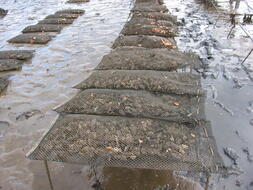
In 2001, the Waddeton Order was established in the upper reaches of the Dart Estuary near Galmpton. The Waddeton Order is a Hybrid Regulating Fishery Order created to help promote the sustainable growth of Mariculture within the District. Through the Order the D&S IFCA manages 117 hectares of the estuary and fundus for the sole purposes of Mariculture, through a lease from the Duchy of Cornwall. D&S IFCA then sub-lets small highly affordable plots out to prospective mariculturists. Mariculture production from within the Waddeton Order is primarily pacific oysters, however there are licenses to farm several other species on the plots, including mussels. The oysters in the Dart Estuary are farmed both using trestles and the PARC system. The PARC system works by placing oysters directly on the sediment with only small barriers separating different size grades of oyster. It is a relatively low impact and cheap way of farming oysters but comes with the drawback of greater stock losses, both to predators and extenuating environmental conditions, i.e. strong tides. There is also cultivation of pacific oysters on trestles in the Dart Estuary outside and downstream of the Waddeton Order area. All oyster beds in the estuary are currently classed as either Bs or long-term Bs. If you are interested in starting a mariculture business within one of our Waddeton plots, or want to find out more please contact us.
TAW-TORRIDGE ESTUARY
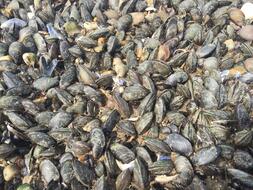
The Taw Torridge mussel beds are the largest public beds in the D&S IFCA’s District. The Taw Torridge Estuary is a Site of Special Scientific Interest (SSSI) and is of major importance for its overwintering and migratory populations of wading birds. Mussels are an important food source for these overwintering bird populations. Due to the increased interest of removal of mussels from the intertidal areas of the SSSI, Natural England introduced, in collaboration with D&S IFCA, a restriction on the amount of mussel that can be removed per month in order to provide enough food resource for the wading birds. In 2014 there was a major decline in the mussel stock on the estuary following the severe winter and storms. This restriction also aided recovery of the mussel stock on the public beds.
D&S IFCA surveys the beds annually to monitor any changes to stock levels and to inform the monthly commercial take of mussels from the classified beds within the estuary. In 2020, D&S IFCA began investigations of the subtidal mussel resource available in the estuary, to inform development of a Management Strategy for the Taw-Torridge. These investigations were developed further in 2021, including an additional survey of the subtidal resource using Side Scan Sonar and grab sampling, which will inform management in the area. Classification for the harvesting of mussels has been in place in the estuary since 1992, and new classifications created covering the public beds since 2014. Many of these beds have long-term B classifications.
In 2014, Pacific oyster farming started in an area of the estuary that is classified as a long-term B harvesting area. Oysters within the Taw Torridge Estuary are farmed on trestles and sold to local businesses.
Outside of the Taw Torridge Estuary, in Bideford Bay, a Marine Licence Application has been submitted for a seaweed farm. The seaweed farming business has liaised with D&S IFCA and the local fishing industry in finding a suitable location of the farm which least impacts the existing users of the area.
LYME BAY
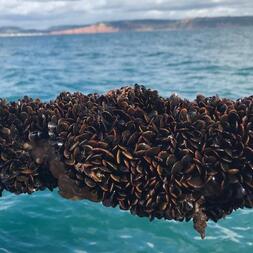
Within D&S IFCA’s District most of the mariculture takes place in estuaries or inshore along the coast. In Lyme Bay, however, in recent years there has been the development of an offshore rope grown mussel farm owned by Offshore Shellfish Ltd. This is the first large scale fully offshore rope grown mussel farm in the UK. The farm consists of three sites between three and six miles offshore in Lyme Bay. The three sites cover 15.4 km2. The mussels are grown on subtidal ropes suspended between pilings in the substrate, and heavy-duty buoys which keep the ropes taught. The mussels on the ropes take advantage of nutrients in the sea whilst not being subject to the same environmental pressures found in the estuarine environment. This enables them to invest more energy into growth resulting in a large, fast-growing product. The offshore location and size of the farms enable the mussels to be cultivated at low density, which is beneficial for growth rate and meat content.
Two of the farm sites, positioned four to six miles from the shore, are currently classified for harvesting (seasonal A/B and class A). The substrate for mooring the ropes has been leased from the Crown Estate currently for a period of 15 years. The farms are projected to produce a yield of 10,000 tonnes of mussel per annum once fully developed, and the company has invested in both technology and infrastructure necessary to deliver this production quantity. The company uses two specially built boats which access the ropes using hydraulic cranes for harvesting, grading, and cleaning work. A marine jetty was constructed in Brixham harbour in 2019 solely for the purpose of offloading mussel quickly and efficiently.
There has been extensive research, particularly through Plymouth University PhD studies, conducted on the impacts of the farm on the surrounding environment and its overall ecosystem effects. Recent findings are summarised here, including increased biodiversity found on and surrounding the ropes with heightened abundances of commercial species such as brown crab and lobster being associated with the ropes.
(Photograph copyright Offshore Shellfish Ltd).
TORBAY
The first rope-grown mussel farm in D&S IFCA’s District was established in Torbay. Although much smaller in scale compared to Lyme Bay’s farm, it is an important aquaculture asset within the Bay. Branch ropes covered in the mussel spat are suspended off a single leader rope held up with buoys, the leader rope is then lifted to gain access to the branch ropes for collection and grading etc. The bed is a long-term class B and is currently farmed by Brixham Seafarms Ltd.
Torbay is also host to a scallop ranch where scallop seed is being grown in lantern nets. The ranch is yet to be classified but it is an exciting development and research is being undertaken into the growth rate and meat content of the scallops. The operators have also recently developed a scallop hatchery in Brixham, which is successfully producing scallop spat to reseed the farm.
Torbay has been an area of interest for seaweed farming. Currently there are several companies interested in setting up seaweed farms in and around the Torbay and Marine Licence applications are being submitted for these mariculture developments.
START BAY
Start Bay has one of the more unique mariculture endeavours within the D&S IFCA’s District, primarily with the harvesting of surf clams Spisula solida. The Bay is relatively shallow with the clams distributed in established natural beds throughout much of the bay. This, although technically not mariculture in the strictest sense (e.g. no relaying of seed), is managed sustainably: the operation uses a single dredge harvester on a part-time basis, with a minimum landing size of 2.5 cm applied, a four-year rotation cycle applied to the areas fished, and only individual clams older than four years are collected to better allow for bed recovery. There are also two large dredge-free areas to the northern and southern extent of the fishery, which limit the expansion of any further dredging activity and afford protection of some of the beds. The waters are classified as long-term B.
PORLOCK WEIR
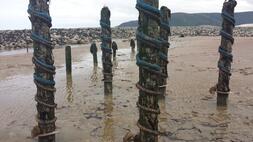
Along the Somerset coast at Porlock, a community initiative to farm shellfish was established in 2014. D&S IFCA worked very closely with the local community in the early stages of setting up the shellfish production areas by offering advice and sources of information. The community initiative primarily focused on the culture of mussels and Pacific oysters. Initially mussels were grown using the novel bouchot technique which originated in northern France and involves tying mussel spat within a long thin tubular net around stakes in the intertidal zone which become submerged during high tide. Unfortunately, this method was not successful due to wave action and subsequent efforts have focussed on farming pacific oysters using trestles. The areas designated for oyster growth have generally been A or seasonal A/B since classification in late 2016.
